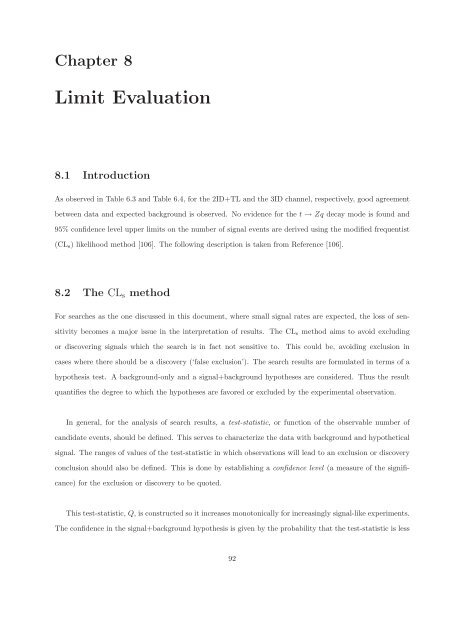CERN-THESIS-2012-153 26/07/2012 - CERN Document Server
CERN-THESIS-2012-153 26/07/2012 - CERN Document Server
CERN-THESIS-2012-153 26/07/2012 - CERN Document Server
You also want an ePaper? Increase the reach of your titles
YUMPU automatically turns print PDFs into web optimized ePapers that Google loves.
Chapter 8<br />
Limit Evaluation<br />
8.1 Introduction<br />
As observed in Table 6.3 and Table 6.4, for the 2ID+TL and the 3ID channel, respectively, good agreement<br />
between data and expected background is observed. No evidence for the t → Zq decay mode is found and<br />
95% confidence level upper limits on the number of signal events are derived using the modified frequentist<br />
(CLs) likelihood method [106]. The following description is taken from Reference [106].<br />
8.2 The CLs method<br />
For searches as the one discussed in this document, where small signal rates are expected, the loss of sen-<br />
sitivity becomes a major issue in the interpretation of results. The CLs method aims to avoid excluding<br />
or discovering signals which the search is in fact not sensitive to. This could be, avoiding exclusion in<br />
cases where there should be a discovery (‘false exclusion’). The search results are formulated in terms of a<br />
hypothesis test. A background-only and a signal+background hypotheses are considered. Thus the result<br />
quantifies the degree to which the hypotheses are favored or excluded by the experimental observation.<br />
In general, for the analysis of search results, a test-statistic, or function of the observable number of<br />
candidate events, should be defined. This serves to characterize the data with background and hypothetical<br />
signal. The ranges of values of the test-statistic in which observations will lead to an exclusion or discovery<br />
conclusion should also be defined. This is done by establishing a confidence level (a measure of the signifi-<br />
cance) for the exclusion or discovery to be quoted.<br />
This test-statistic, Q, is constructed so it increases monotonically for increasingly signal-like experiments.<br />
The confidence in the signal+background hypothesis is given by the probability that the test-statistic is less<br />
92















